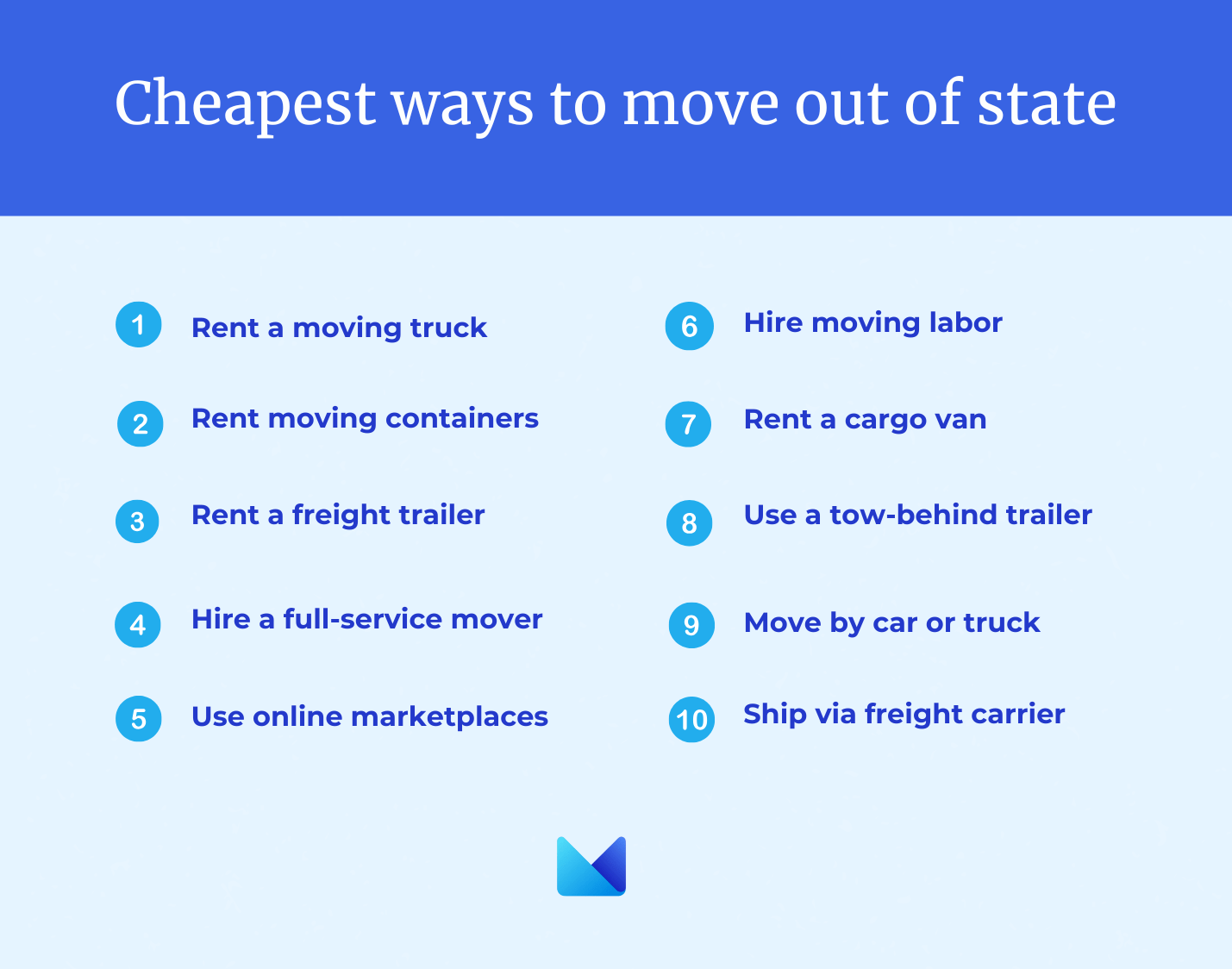The Cheapest Ways to Move Out of State in 2025
Quick answer: The cheapest way to move out of state is typically to rent a truck, moving container, or freight trailer, which can cost anywhere from $700 to $5,000, on average.
In this post, we’re breaking down the cheapest and most cost-efficient way to move. We’ll also give you some tips for reducing your moving costs.
10 cheap ways to move out of state
Preparing for a cross-country move or long-distance move is different from a local move. A lot more can go wrong when you move out of state, and moving costs tend to be significantly higher.
Here are our top choices for cheap out-of-state moves, with the average cost and who they’re best for.
- Rent a moving truck: Best for budget-friendly large moves ($700–$2,000)
- Rent moving containers: Best if you need storage ($900–$4,500)
- Rent a freight trailer: Best for larger moves ($1,500–$3,000)
- Hire a full-service mover: Best for convenience ($1,941–$4,224)
- Use an online marketplace: Best for getting a deal (Cost varies)
- Hire moving labor: Best for DIY hybrid moves ($1,175–$3,090)
- Rent a cargo van: Best for studio apartments ($800–$3,000)
- Use a tow-behind trailer: Best for shorter-distance moves (Cost varies)
- Move by car: Best for dorms and other small moves (Cost varies)
- Ship via LTL freight carrier: Best for flexible small moves ($1,021–$1,708)
1. Rent a moving truck: Best for budget-friendly large moves
With this option, you get the truck for a set number of days based on the distance of your move and do all the driving and heavy lifting. Because the moving company only provides a moving rental truck, you save significantly on moving costs. Just be sure to factor in gas, hotels, meals, and the time it will take to move.
Quick tips:
- Penske, Budget, and U-Haul will price match each other, so get quotes from all three, even if you prefer a particular provider.
- Make sure to account for fuel costs. Diesel trucks get better gas mileage.
- Always try to get the newest moving truck available in the size you need, so you’re less likely to experience maintenance issues.
- Call the day before to confirm your reservation and have a backup option if they don’t have a rental truck available on your moving day.
|
|
|
|
2. Rent moving containers: Best if you need storage
If you need temporary storage or don’t want to drive, a moving container is a great option. The container company will deliver an eight- to 16-foot storage container(s) for you to pack and load, then pick it up and place it in temporary storage or ship it to your new house.
Quick tips:
- Companies like PODS and U-Pack offer different types and sizes of containers. Check which company’s offerings best fit your needs.
- The cheapest moving container rates for out-of-state moves are usually offered by professional moving companies with locations near you on both ends of your move.
- Moving container companies are best if you only need short-term storage, but they can be more expensive than a storage unit over long periods of time.
|
|
|
|
3. Rent a freight trailer: Best for larger moves
Freight companies drop off a 28-foot trailer at your house and give you up to three days to load everything. Then, they drive it to your destination and give you another three days to unload. Depending on the size of your move, they might require more labor than you can handle on your own.
Quick tips:
- You may need help loading and unloading the moving truck, and this option doesn’t offer an extended loading period.
- Freight trailers are great for moving from rural areas or moves where you need your items delivered quickly, but they can be tricky in big cities where parking is limited.
- Some companies will let you put a car in the trailer, as well.
- Trailers have spring suspension, so be sure to pack fragile items carefully.
89% of users select this mover
4. Hire a full-service mover: Best for convenience
Interstate moving companies are great if you have the means and aren’t interested in doing heavy lifting. They handle the loading, driving, and unloading. Full-service movers like Safeway Moving and Mayzlin Relocation can also pack your boxes and offer competitive pricing, with a reputation for quality service.
Quick tips:
- Keep in mind that full-service movers will almost always be pricier than DIY-style options.
- Quotes from full-service movers can vary by thousands of dollars, so be sure to get at least three quotes. Many also price match with their competitors.
- Always confirm that an interstate mover has proper licensure for out-of-state moves.
- Be prepared to pay a deposit. Some full-service movers require an upfront deposit of up to 50% of your total moving costs.
|
|
|
Licensed
Insured
Price
|
5. Use an online marketplace: Best for getting a deal
Use a platform like uShip to find professional help with tasks like packing and loading, including moving single items. You’ll get multiple quotes in a few minutes to find someone with the pricing and availability that fits your needs. You can also use platforms like Facebook and Craigslist to find moving help.
Quick tips:
- Discern. Like with anything, if a deal sounds too good to be true, it probably is. Don’t risk your belongings with a sketchy offer.
- Look at the transporter’s profile for previous reviews and potential red flags. Carefully evaluate this information before agreeing to use their services.
- Make sure your listing includes all the moving services you need, and keep in mind that service providers on these marketplaces usually won’t drive for you.
89% of users select this mover
6. Hire moving labor: Best for DIY hybrid moves
HireAHelper is another way to save on your out-of-state move. The platform will match you with someone to load your moving truck or container. You can hire movers on an hourly basis and enjoy peace of mind with a $1,000 money-back service guarantee.
Quick tips:
- You need to vet your moving labor before agreeing to use their services. Fortunately, platforms like HireAHelper do a lot of the vetting for you.
- While moving labor can help with packing, loading, and unloading, you’ll usually need to take care of transportation yourself.
- Be sure to make arrangements for both your old and new homes, as you’ll have different sets of movers for each location.
89% of users select this mover
7. Rent a cargo van: Best for studio apartments
Cargo vans make getting through traffic and parking easier, and you get better gas mileage than with a moving truck. They’re available through some moving truck companies but are often limited to in-town moves only. While Penske rents cargo vans for interstate moves, U-Haul only allows cross-town moves.
Quick tips:
- Like with a moving truck, you’ll be required to do all the lifting and loading yourself.
- To save money, buy packing supplies on your own. If you have a little extra room in your budget, you can also hire professional movers to pack.
- Before settling on a vehicle, determine the space you need. For anything larger than a studio apartment, you’ll probably need a moving truck.
8. Use a tow-behind trailer: Best for shorter-distance moves
A tow-behind trailer is an excellent option if your vehicle has the towing capacity. Rental truck companies like U-Haul offer tow-behind trailers in multiple sizes with no mileage fee. The largest cargo trailers are roughly the size of a small moving container, so they’re best for studio or one-bedroom apartments.
Quick tips:
- Trailers can be dangerous. If you don’t have experience hitching and driving a trailer, moving day isn’t the time to learn.
- Be sure to factor in the cost of packing supplies, including bubble wrap and packing tape.
- Learn trailer safety tips. Don’t exceed your vehicle’s towing capacity, drive slowly, and be cautious during turns.
9. Move by car: Best for dorm rooms and other small moves
If you’re moving out of a dorm or other small space, you can likely cram all your belongings into your car. One advantage (besides saving a lot of money) is moving your car and items at once. If this is a temporary move, you may need to put furniture and larger items in a storage unit.
Quick tips:
- Cars have limited space, so you’ll need to pack carefully to fit everything. You generally won’t have room for any furniture.
- Make sure you load your items in a way that doesn’t limit your visibility, so you can check your rearview mirror and blind spots.
- If you can’t make the trip in a single day, find a safe place to park at night to reduce the risk of anyone trying to break into your vehicle.
10. Ship via LTL freight carrier: Best for flexible small moves
LTL stands for less-than-truckload. The freight company combines your move with other ones to fill the space on a truck and charges for the space you use. LTL shipping is a flexible option if you aren’t sure how much space you’ll need for your stuff, but the delivery takes longer.
Quick tips:
- You pay based on how much space you use. You’ll get a quote, and the final price will be adjusted to reflect the actual space you use.
- Pack efficiently to lower your costs by reducing how much space you take up inside the truck.
- Be aware of the risk of damage. Different people loading and unloading the trailer can increase the chance of damage to your items.
- You may need to palletize your items. Package them efficiently to avoid using extra pallets and incurring damage.

Other ways to save money on your move
In addition to hiring the right moving services, here are a few ways to stretch your moving budget during the moving process.
- Declutter: You can declutter for your move by selling things you don’t need at a garage sale or donating them. Selling enough stuff could allow you to rent a smaller moving truck or moving container.
- Cheap moving boxes: Look for cheap or free moving boxes. Ask for extra boxes at grocery stores, liquor stores, neighborhood Facebook groups, or Craigslist.
- Ask for help: Ask friends and family members to help with the packing and unpacking to lighten the load.
- Moving insurance: See if your homeowner’s insurance includes moving insurance, which could save you thousands in moving costs and save you from paying for more expensive insurance from your mover.
- Moving discounts: Look for moving discounts for seniors, military service members, and others. A lot of movers also offer seasonal discounts throughout the year. It never hurts to ask!
- Parcel carrier: If you only need to move a few items, consider a parcel carrier like USPS or a train. While they can’t be used for heavy items, they’re a safe and cost-efficient way to get small shipments out of state.
How much does it cost to move to another state?
As you can see, a lot of variables can affect moving costs. In general, the cheapest way to move out of state can range from less than $1,000 with a rental truck to $12,000 or more with a full-service moving company.
For out-of-state moves, here are the biggest factors that affect moving costs:
- The size of your move
- The distance
- Type of mover you use
- The moving services you choose
The more work you do yourself, the more you can save, and the larger the move and the greater the distance, the more expensive your move will be.
Our moving cost calculator will give you a pretty good idea of your moving costs for different types of moves if you enter your move dates, origin and destination cities, and the estimated size of your move.
For a general idea of what your move could cost, here are some sample price ranges for out-of-state moves with different types of movers for a two- to three-bedroom home:
| Distance | Rental Truck | Moving Container | Full-Service Mover |
|---|---|---|---|
| 250 miles | $305–$635 | $1,082–$2,235 | $1,531–$4,481 |
| 1,000 miles | $768–$1,524 | $1,690–$3,298 | $2,511–$5,972 |
| 2,500 miles | $1,668–$3,445 | $2,446–$5,399 | $3,563–$6,988 |
FAQ
What is the cheapest option to move out of state?
What is the least expensive month to move?
What is the cheapest way to move a long distance?
What is the easiest way to move from one state to another?
How much does it cost to move to another state?
Not what you were looking for?
Check out other categories that can help you find the information you need!













